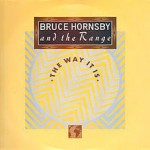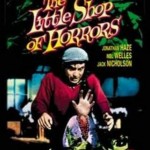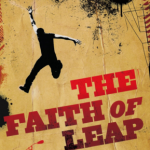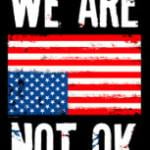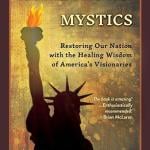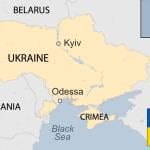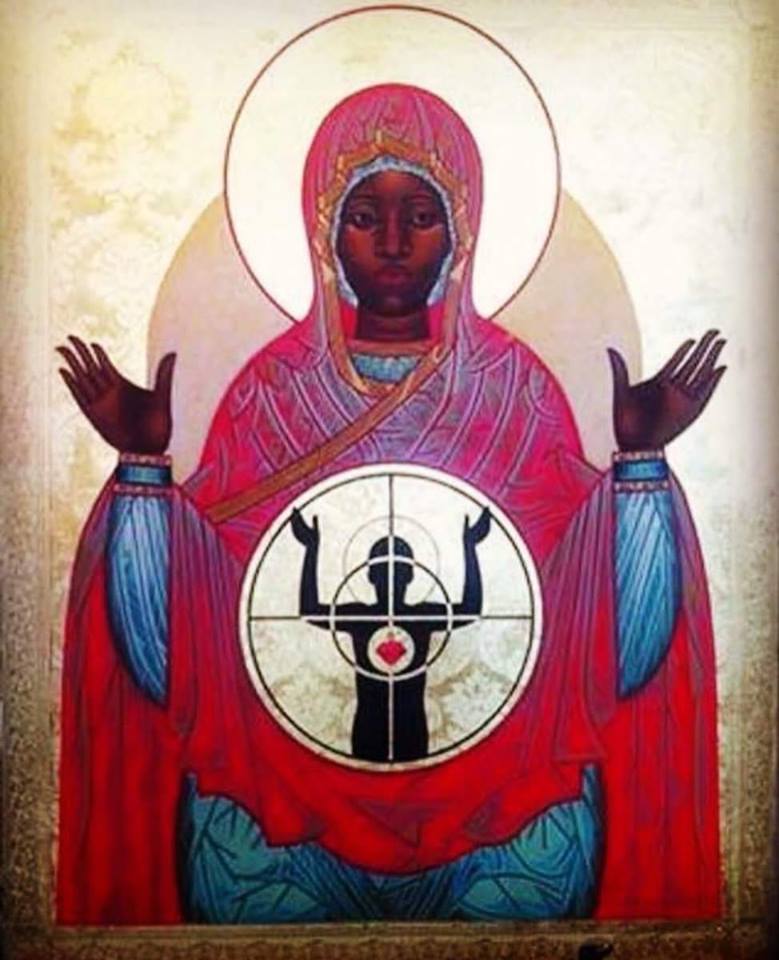
The icon pictured above is of Our Lady of Ferguson written by Mark Dukes (with design assistance from Fr. Mark Bozzuti-Jones).
This is post number 5 in a series on the church and racial justice called How the church can SURJ.
I am speaking from the edge of the inside of a mainline church. This is where I live and work. I’m a local pastor and an introvert. In the church world around me, I am mostly invisible in plain sight. In this series, I am speaking up within the surround-sound of racial justice silence. I can’t ‘be woke’ and do otherwise.
In the recent days, two more black men have died at the hands of police in the United States. More people are coming to realize that our criminal justice system is broken. Our gun laws are broken. Our society is broken. And our churches are also broken. However, this is neither new, sudden, or surprising. This is the ongoing history of church and society in the United States. ‘The only difference now is the presence of camera videos and social media.’
In the mainline church, each time a black person dies at the hands of law enforcement a familiar ‘liturgy’ is literally set into motion. I call it the ‘racial injustice liturgy.’ It is revised from the previous version so the necrology (names and city locations of the deceased) are reflected. Then there are myriad Facebook posts to decry ‘police brutality’’ (when what has taken place is not mere brutality, but killing). In the Twittersphere, links are provided to ‘helpful prayer resources’ (so we can all add these to our Sunday bulletins).
Then the liturgy continues with more postings about ‘the current political climate’ and the ‘sudden rash of racial violence,’ and the same questions are posed: ‘How, in the 21st century, can this still happen?” (although since President Obama was elected, and now with Donald Trump as a presumptive presidential nominee, the iceberg of hidden American racism is coming more and more to the surface.
In the midst of our prayers, the fact remains that physical (and more pervasively, systemic and economic violence) against African Americans continues by police, white supremacist militias, court justices, bankers, real estate agents, housing developers, ‘patriot’ citizens, conservative church preachers and progressive church structures. What we are experiencing is only the latest chapter in the long and ongoing history of systemic racial violence, discrimination, and legislated inequity. All of this is mostly accompanied by the sounds of white silence, which continues to be very effective in keeping racist systems in both church and society in place.
Racism is as much a problem in the church as in society at large, and perhaps even more so. The segregation of Sunday morning is most of our churches long known reality. Yet we in the church have at our disposal, a massive set of spiritual resources to inspire and empower change, yet too we often fail to leverage these resources by putting them into practice in day to day church life, ministry, and mission.
We know ourselves to be agents of something called the Reign or Kingdom of God, and the New Creation. So why does the church continue to remain on the sidelines, sitting on its agency? I believe it has to do with the ‘theology of being polite,” the non-spiritual ‘practice of silence,’ and the lack of intentional effort in ‘desegregating our spiritual lives.’
The focal of church change begins at the judicatory level. There are always majority white congregations, cities, towns and suburbs, where the ‘liturgical’ response is: ‘We don’t have black neighbors or congregant here.’ However, in most of our judicatories, ‘that dog won’t hunt.’ In the mainline church world, local congregations will never be more racially inclusive, diverse and just, than the power and authority systems in place in the local synod/diocese/conference and district.
In my own majority white church system, only once do I recall anyone speaking up in a public way. It was in a Facebook post, asking, essentially, How do ‘Black Lives Matter’ in our churches here?
The person who did this speaking up is very brave. He is not a clergy person but is is a church lay leader with a substantive social media presence. The response to his post? Silence. So far there has been no judicatory wide conversation on racism in church and society. No conversation at a church convention. No conversation at a clergy gathering, or any other gathering of clergy and lay leaders that I know of. Active hope begins where such begins to happens. White clergy leaders must ask for it. Those in power should see to it and schedule it. Racism in the United States is a white issue, so white leaders in the church need to stand up and speak out.
In my own experience, and on quite a few occasions I have mentioned to clergy friends what it is like to do ministry in a white dominant context as a black church leader. I have shared my longing for local action to be taken by white church leaders in power to change the equation and put in place the kind of church here that we all say we want to be part of. But then, the awkward conversation ends, polite goodbyes are said, and things go on as they always have, and the overall silence continues.
Into this silence, what is needed is a movement from ‘prayer alone’ into SURJ action from white clergy in within their own judicatory. Without action to accompany it, the distribution of prayer resources about justice for black lives ‘out there,’ will not accomplish justice for black lives ‘right here.’ Change will only begin to take shape ‘out there’ by starting with change right here (and wherever ‘here’ is for you). Gandhi said it the most inspiring and redeeming way. ‘We must become the change we seek in the world.‘ I say to the church, practice the change you seek in the world within your own local church context.
The voice the church raises in the public square will only be heard by those outside the church, when those in the church first raise our voices and implement change within our own church household. Changes to the racial composition of our judicatories structures, committees, boards, councils, and senior judicatory leadership, so these begin to reflect the racial justice and inclusion we pray for in our wider society. The Christian tradition is chocked full of hope. It is now kairos time for this hope to grow legs, stand up and take action. So, let us begin.
Preparation: Contemplate before the icon of Our Lady of Ferguson. Notice her upright and standing posture. Pray for courage to stand up for racial justice in your own church system and for an end to your own personal silence. Conduct a personal spiritual inventory for racial justice. Ask yourself how have you been an active accomplice for racial justice in your local church system? How have you supported local ministry with black folks within your own judicatory? How have you supported black clergy and lay leaders in your own judicatory? If you have not done so before, you can always begin in the ‘eternal now.’ which God provides.
Activity: Take a close look at your local judicatory structures, boards, judicatory staffs and councils … then answer the following questions: Are local black ministries within your own judicatory resourced and funded? Are your local black leaders given a voice, vote, and seat where missional strategy and decisions are made and mission funds are allocated? Are there any black leaders on your local judicatory senior staff? Is there any black person in a funded, judicatory level mission leadership position ? If not, ask your judicatory head to make such hires and appointments. This is a first step and necessary step in making our church prayers for racial justice, equity, inclusion, power sharing, reparation, and reconciliation, ‘happen.’
Action: ‘Get up off of your knees.’ Show up, and begin to make change happen in your own spiritual house.
Support local ministries with black people, and led by black leaders, and fund them. Put your some of your economic resources where your prayers are. Once racial justice action begins to happen within your own house, from there you can go with integrity into the streets, the neighborhood association, the city council chamber, the police department, and the mayor’s office in your city, town, suburb and cul de sac and demand similar action. Without internal action, the external witness of the church, although true and righteous, will ring hollow.
We have all of the spiritual resources needed to make internal change happen. What is lacking is to get up off our knees and begin to make concrete changes to transform our churches and then to make changes in our society at large.


